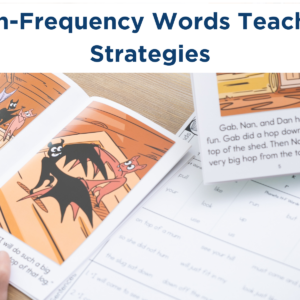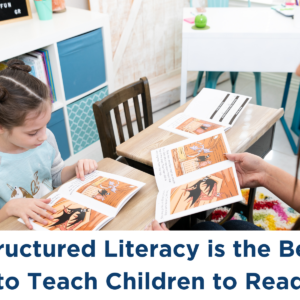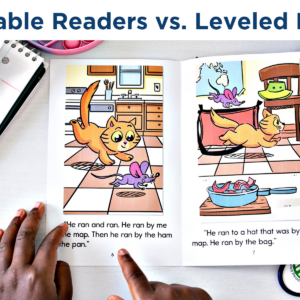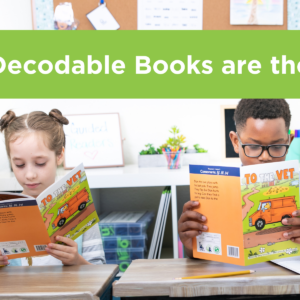Have you ever been told that leveled readers are the gold standard for teaching children to read? Well, brace yourselves. That’s one of the biggest myths in education today.
You’re likely reading this because you deeply care about helping children learn to read. And, if you’re like me, you may have been using leveled readers in the classroom for years. I used them for most of my 23-year teaching career, and I truly believed I was doing the right thing. But I will turn that notion on its head today as we dive into the transformative power of decodable texts.
To help you get started, I’m sharing five game-changing tips that will help you redefine your approach to reading instruction. As a bonus, I have a free downloadable resource that you don’t want to miss!
1. Introduce Decodable Texts After Explicit Instruction
It’s best to give the students explicit instruction before introducing a decodable reader. You want to provide instruction on the letters and sounds that are included in the text. This ensures that students have the foundational knowledge to decode the words they’ll encounter, making the reading experience more meaningful.
Before introducing a new decodable text to your students, introduce them to the specific words they’ll encounter in the text that they may struggle to decode. Many decodable books, including our books from Structured Literacy with E.A.S.E., include an introduction in the beginning to the words students will encounter in the text, including things like:
- High-Frequency Words: also known as “heart words”
- “Wise words”: words that are decodable but may not have been explicitly taught at that point in the scope and sequence
- Warm-up words: words that will warm them up for reading
- Preview words: words that help give the story some depth
- Irregular high-frequency words: words that students may already have experience with or new ones they’ll experience in the book
It’s always helpful to do pre-teaching or a preview of the words before having students jump into a decodable text. This allows them to have some experience with the words before encountering them in the book, which can create a less frustrating experience.
2. Introduce Blending
We will level up blending by doing word mapping and word-chaining activities.
Word mapping
Word mapping is simply helping students connect the sounds they hear (the phonemes) to the letters that make the sounds (the graphemes). This is a crucial part of helping students learn the alphabetic principle.
A really effective way to do word mapping is by using a simple grid or chart. I like to use Map-Its Paddles because they’re easy to use and amazing. Here’s an example of how you would phoneme-grapheme map the word ‘cat’ with your class:
- “Friends, repeat this word after me, ‘cat’.”
- Students repeat the word ‘cat’.
- “Let’s think about all the sounds in the word ‘cat’. /k/ /ă/ /t/. How many sounds did you hear? Let’s do it again. /k/ /ă/ /t/. Three sounds. Very good.
- Move three counters up on your Map-Its Paddle
- “Okay, what was the first sound in the word ‘cat’? /k/. We’re going to move the first counter up and say /k/.
- “What’s the next sound or phoneme you hear in the word ‘cat’?
- Students say /ă/.
- “Let’s move up the counter and say /ă/.”
- “Very good. Now, we’re going to think about the last sound. What was the last sound we heard in the word ‘cat’?”
- Students say /t/.
- Move up the counter. “What letter or grapheme makes the /t/ sound?”
That is word mapping. It’s quick and simple but very effective in helping students map the sounds to the letters.
There’s a process in the brain called orthographic mapping. This is where the brain maps the graphemes to the sounds in the brain and cements them together. So, when the brain sees that word again and again, it will automatically retrieve it. Phoneme-grapheme mapping is an activity that helps that natural process happening in the brain.
Word Chaining
Another way you can help with orthographic mapping is through word chaining. Word chaining is similar to word mapping but you make multiple words using specific letters and sounds.
For example, you may have students begin with the word ‘sat’ and have them change the word to ‘mat’. Students need to determine what letter needs to be changed to build the new word. You can also have students build a word and then give them the sound you want to replace with a new sound. This asks them to match the phoneme to the grapheme while focusing on decoding and spelling. Have students use a work mat to write the words out as they go.
If you want to learn more about word chaining activities, watch this video: Implementing Structured Literacy: Word Chaining
These are activities you can do prior to introducing a decodable book. We want to give students some practice playing with words, sounds, and letters. This can help reduce their frustration when they get into the decodable reader.
some practice playing with words, sounds, and letters. This can help reduce their frustration when they get into the decodable reader.
So, between blending, phoneme-grapheme mapping, and word changing, you’re really building a powerhouse of activities that teach and solidify phonics skills. Remember, the Science of Reading shows that explicit instruction in these areas will be a fast-track ticket to reading success.
3. Align Decodables with Phonics Lessons
It’s crucial to ensure that the decodable books you use in the classroom are specifically and explicitly aligned with your scope and sequence. I often hear teachers asking, “What are the best decodable books to use?” but this is the wrong question. Instead, we need to be asking “Which decodable books match the scope and sequence that I’m using in the classroom?”
Our Structured Literacy with E.A.S.E. curriculum has an explicit scope and sequence, which you can download for free. It’s very explicit and systematic.
We’ve also created our Developing Decoders decodable books to align with UFLI’s scope and sequence. You can find these decodables in the UFLI decodable text guide. So, check out our Developing Decoders books if you’re using UFLI and looking for specific decodables that align exactly with their scope and sequence.
The phonics lesson sets the stage for when the decodable book comes into play. We have to ensure we’re using those decodable books because mastery happens during the application of the skill, not just exposure to it. So, we don’t want to just expose students to the sounds, we want them to master the sounds.
Therefore, decodable books are most effective when used directly after a phonics lesson. They give students a chance for immediate application to reinforce the phonics skill that was taught. This makes the skill more likely to stick with the students.
4. Bring in Comprehension Skills
Decodable books are not just about decoding. It’s important that they also incorporate tools for learning and practicing comprehension. Decoding is only the first step. We want students to read the words and understand them in context. Comprehension is an important part of Scarborough’s Reading rope.

Decodable readers offer that golden opportunity for your students to build comprehension skills while practicing their decoding skills. The words in the text may be simple, but the stories can still be rich and engaging.
 For example, the decodable book Shush has a bit of a problem. The pup keeps barking, which causes a conflict. The story also lends itself well to a beginning, middle, and end writing activity. In addition, you can use many questions with good decodable books to bring in comprehension practice.
For example, the decodable book Shush has a bit of a problem. The pup keeps barking, which causes a conflict. The story also lends itself well to a beginning, middle, and end writing activity. In addition, you can use many questions with good decodable books to bring in comprehension practice.
Many times throughout the years, in my own classroom, I had students who were amazing decoders but had absolutely no idea what they read. It doesn’t seem like that should be possible, but it happens.
So when using decodables, ask students questions and have them do writing assignments or dictate writing sentences about the story to help aid in comprehension. For example, from the decodable Shush, you could ask, “Why was Shad watching the twins?”
There is a lot you can do to incorporate comprehension skills using decodable books. Remember, it’s not just about decoding. We’ve got to consider the upper strands of Scarborough’s rope to build language comprehension. It’s so important.
5. Make it a Routine
Last but definitely not least, it’s important to make it a routine. Decodable texts should be part and parcel of every single piece of your phonics and reading instruction. Early literacy expert Wiley Blevins says that at least half of phonics lessons should be devoted to application. So, work to split your time efficiently and plan out activities to use before, during, and after reading.
Routine practice helps develop great readers. Remind yourself again that mastery is in the application, not just exposure. That’s so important. The mastery happens when students apply the skills they’ve learned, not just get exposed to the skills or practices that you’re teaching them.
Download Free Decodable Readers
These five game-changing tips can help you maximize the benefits of decodable texts in your classroom. From understanding when to introduce decodables to using them to teach comprehension, these strategies are designed to elevate your reading instruction.
And we’ve just scratched the surface here. Decodable texts are a vast landscape, and there is so much more to explore and apply.
If you’re wondering where to start, I’ve got you covered. You can download 16 free decodable books that are perfectly aligned with UFLI’s scope and sequence. You can download them, print them, and use them in your classroom. Trust me, this is a resource you’re not going to want to miss.







